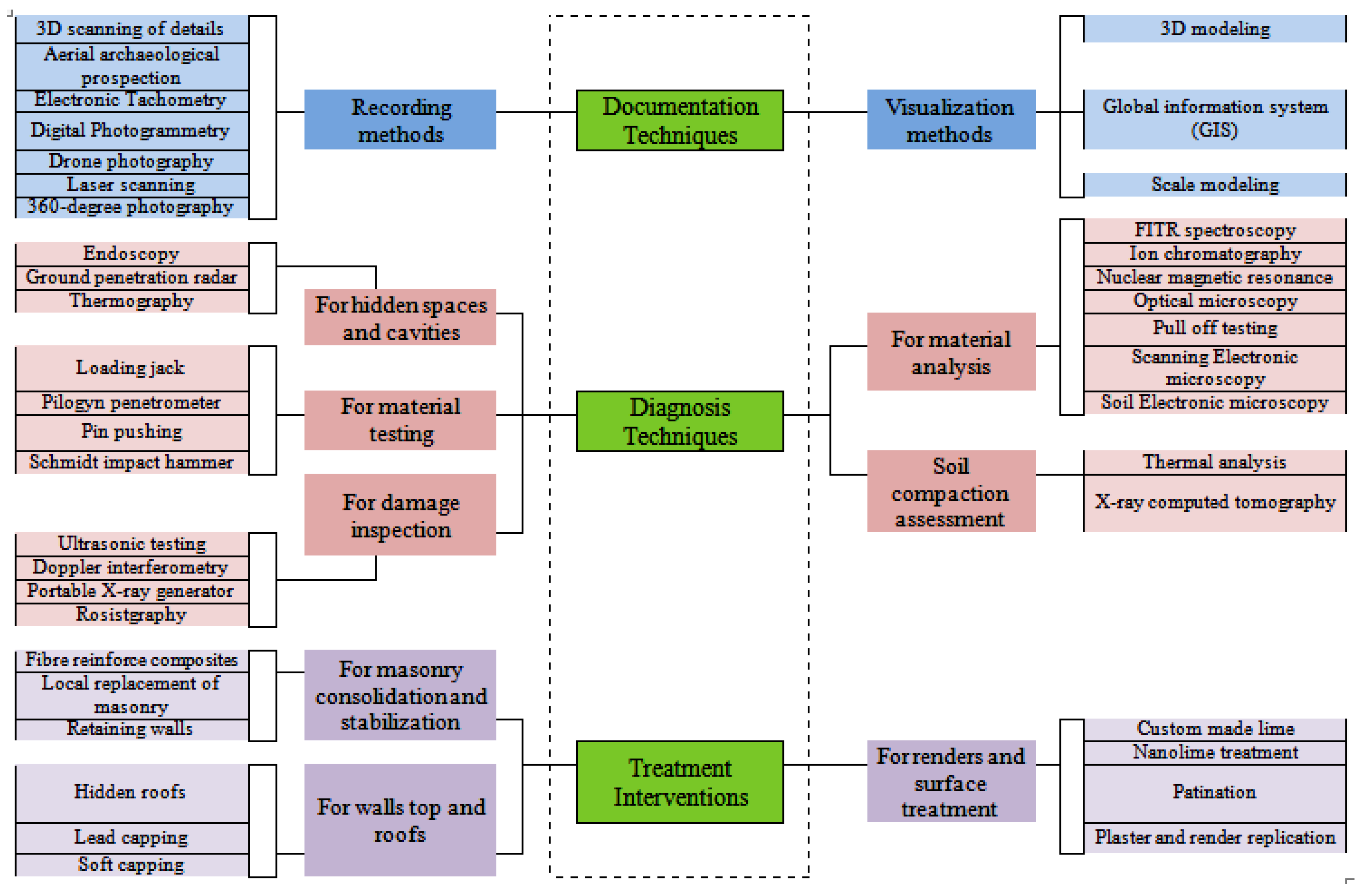Quest for an Innovative Methodology for Retrofitting Urban Built Heritage: An Assessment of Some Historic Buildings in Kano Metropolis, Nigeria
Abstract
1. Introduction
1.1. Cultural Heritage Sites in Kano, Nigeria
- a.
- City wall and gates: the gates which have 15 doors, as reviewed, entail 8 traditional entryways (erected with mud), 6 modernized doors (reconstructed in concrete), and 1 present-day door (ongoing project with concrete). Nevertheless, the Kano city wall remains a good-natured declaration of African indigenous deployment of its engineering to distinguish political space, as a safeguard and defence structure, a working alliance, and the executive, to mention a few (see Figure 2).
- b.
- Kurmi Market was the foremost and principally recognized marketplace that has been in existence as long as the old Kano city. Its planning was astounding and innovative in the engineering development in the design of the market layout. While investigation reveals that it was rarely conserved, relatively it has undergone a few transformations to the level that it has mislaid its historic signature to unnecessary modernism [13].
- c.
- Kano Emir’s Palace was founded by the Emir of Kano, Sarki Muhammadu Rumfa, who ruled from 1463 to 1499. The palace has three doorways, to be precise Kofar Fatalwa, Kofar Kwaru, and Kofar Kudu (shown in Figure 3). The palace is divided into three fragments; the administrative structure with spaces (Rumfar Kasa, Soran Zauna Lafiya, Soron Bello, and Soron Giwa) is situated in the south. The focal fraction entails the Emir’s family while the northern parts remain for the servants’ and workers’ quarters [15].

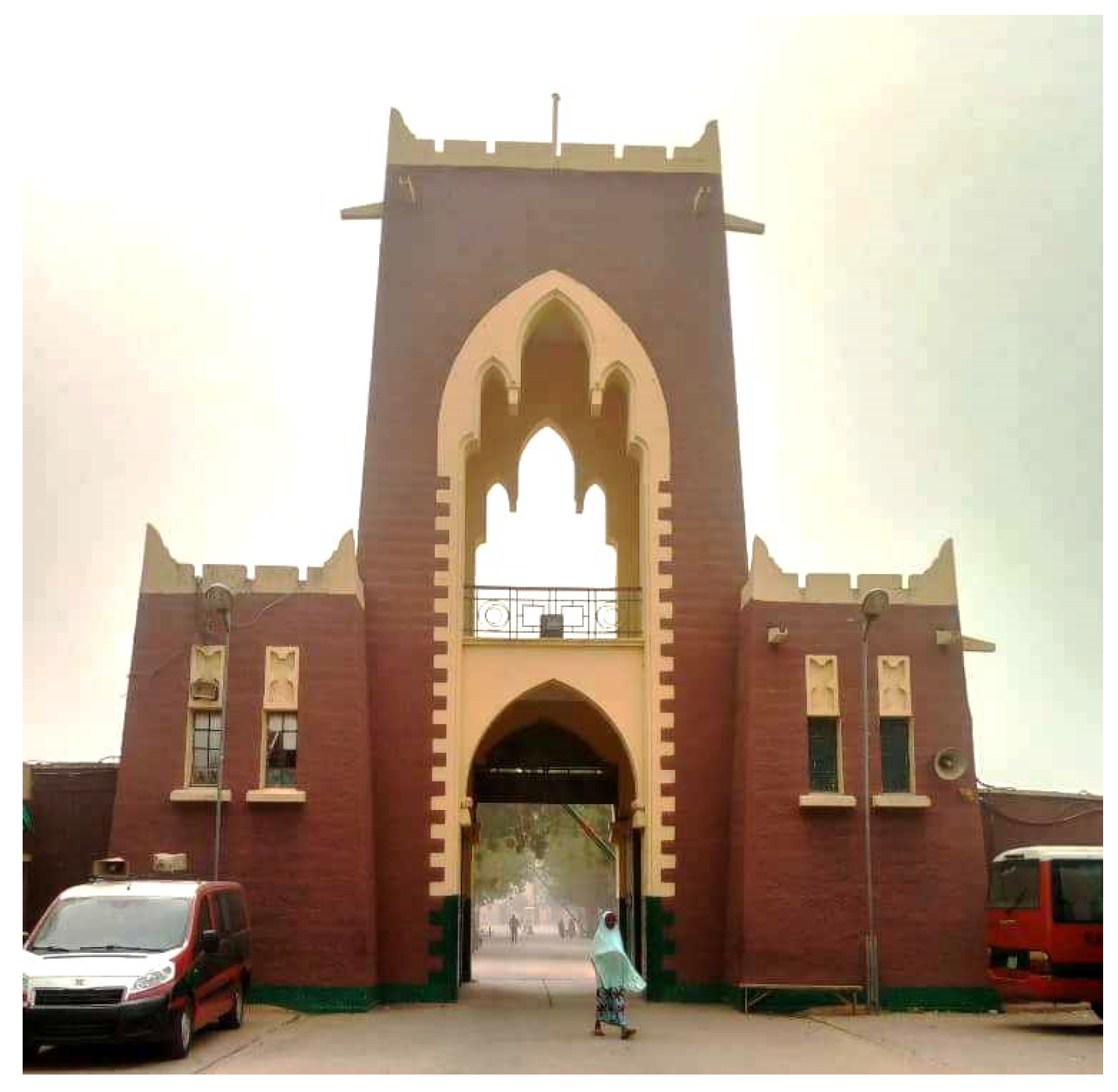
1.2. Contemporary Methodologies for the Conservation of Architectural Heritage
1.2.1. Documentation Techniques
1.2.2. Diagnostic Methods
1.2.3. Treatment Interventions
2. Materials and Methods
3. Results
3.1. Description of Selected Pre-Colonial Buildings
3.1.1. Dorayi Palace
3.1.2. Shatsari Arab Mosque
3.1.3. Gidan Shattima
3.2. Description of Selected Colonial Buildings
3.2.1. Masaka Textile Mill
3.2.2. Kofar Kudu Sharia Court
3.2.3. Gidan Alhassan Dantata
3.3. Description of Selected Post-Colonial Buildings
3.3.1. Mambayya House
3.3.2. Gidan Haruna Kasim Fagge
3.3.3. Gidan Ado Bayero
4. Discussion
4.1. Pre-Colonial Buildings Conservation Interventions
- i
- Dorayi mini palace is an example of Hausa traditional architecture built in the late 1800s and remains among the rare palace architecture in northern Nigeria. The walls and roof of the palace are enriched with colorful motifs and engraving work.
- ii
- Shatsari Arab Mosque is also an example of Hausa traditional architecture and remains one of the most aged religious buildings in northern Nigeria as it was founded in the early 1800s. Shatsari Arab Mosque serves as a symbolic monument of socio-economic development in Hausaland during the early trans-Saharan trade.
- iii
- Gidan Shattima is another example of Hausa traditional architecture that has undergone rigorous evolutionary changes that have transformed it into contemporary architecture. The transformation started from pre-colonial building to colonial and it has now been rehabilitated as a post-colonial building. The reconstruction is ongoing at the time of the survey and none of the 15th-century materials have been restored yet; it serves as a source of knowledge about architectural revivalism in Hausaland. The building serves as a historic monument to the socio-political and economic development of the Kanawa and northern region (before and after Nigeria’s first republic).
4.2. Colonial Buildings
- i
- Masaka textile mill is an example of colonial architecture built in late 1956 and remains among the rare industrial developments in northern Nigeria. Masaka textile serves as a symbolic monument of the socio-political and economic development of Nigeria during the Nigerian civil war. It not only produced uniforms worn by the heroes but served or rather produced clothing for many unions, schools, governmental, and non- governmental institutes before its closure.
- ii
- Kofar Kudu sharia court is a model of colonial architecture and remains among the rare buildings in Kano municipality as an aged judicial building in northern Nigeria, as it was founded in 1928. It serves as a symbolic monument of the legal system in northern Nigeria before and after colonial supremacy.
- iii
- Gidan Alhassan Dantata is an example of trado-modern architecture of its time; while it was built from modern materials, it adopted Hausa traditional architecture typology. It remains among the rare mixed-used dwellings within Kano city as well being the first personality building in northern Nigeria that imported western construction materials and skills. It was founded in the late 18th century and serves as a symbolic monument of the socio-economic development in Hausaland and Nigeria during the trans-Saharan business and Nigerian commodities trade.
4.3. Post-Colonial Buildings
- i
- Mambayya House particularly Malam Aminu Kano’s Living History Museum is an example of post-colonial architecture, built in 1973, and remains among the rare residential structures of its time. The museum serves as a symbolic monument of the socio-political and cultural development of Nigeria’s first republic and beyond. Hence, it serves as a resource of information on democratic studies in Nigeria.
- ii
- Gidan Haruna Kasim is a replica of post-colonial architecture and remains among the rare residential buildings of its time in the metropolis. It serves as a symbolic monument of prefabricated residential structures in northern Nigeria. Despite importing foreign materials and skills, it adopts traditional architectural typology. Consequently, it is a source of knowledge in contemporary architecture.
- iii
- Gidan Ado Bayero is an example of post-colonial architecture and remains among the rare high-rise buildings in Kano. It was founded in the early 1980s and serves as a symbolic monument of the socio-political and economic development in northern Nigeria during the second republic and beyond.
4.4. Results Summary
5. Conclusions
- i
- Student architects should be prepared to acquire the basic knowledge of architectural heritage conservation techniques. Furthermore, new generations of architects must gain knowledge of the contemporary methodologies for the conservation of built heritage.
- ii
- The heritage assets of Kano, as well as Nigeria, calls for guiding principles and implementation. This shall spell out in detail the preservation schedules and conservation management plans.
- iii
- As in other countries, such as China and Italy, rigorous penalties should be forced and authorized on violators of the heritage conservation conducts and principles.
- iv
- As in many cities, and countries, especially ancient or historic metropolises, the surveyed buildings could, therefore, be selected by the government (local, state and national) through concerned authority for conservation and restoration. In such a regard, the interventions should be guided by historians, architects, and conservationists (care specialists, technicians, scientists, educators, and administrators).
- v
- Funds ought to be appropriated and mobilized for the restoration of deteriorating assets, whereas attempts ought to be made to pronounce some of the surveyed buildings as national monuments and once this is achieved, immediate and proper funding should be put in place.
Author Contributions
Funding
Data Availability Statement
Acknowledgments
Conflicts of Interest
References
- Kabir Umar, G.; Yusuf, D.A.; Ahmed, A.; Usman, A.M. The practice of Hausa traditional architecture: Towards conservation and restoration of spatial morphology and techniques. Sci. Afr. 2019, 5, e00142. [Google Scholar] [CrossRef]
- Kabir, G.U.; Yusuf, D.A. SOCIO—Cultural rejuvenation: A quest for architectural contribution in kano cultural. Int. J. Adv. Acad. Res. Soc. Manag. Sci. 2019, 5, 46–56. [Google Scholar]
- Akinbamijo, O.B.; Alakinde, M.K. Nigerian Heritage and Conservation Landuses; Challenges and Promises. Int. J. Educ. Res. 2013, 1, 1–10. [Google Scholar]
- Murzyn, M. Practical Aspects of Cultural Heritage. HERMES. 2008. Available online: www.swkk.de/hermes/research/Buchbeitraege/HERMES/ (accessed on 23 January 2022).
- Cullingworth, B.; Nadin, V. Town and Country Planning in the UK; Routeledge: London, UK, 2002. [Google Scholar]
- NCMM. Declared and Proposed National Monuments. 2019. Available online: http://ncmm.gov.ng/declared/ (accessed on 14 June 2022).
- Okpalanozie, O.E.; Adetunji, O. Architectural Heritage Conservation in Nigeria: The Need for Innovative Techniques. Heritage 2021, 4, 120. [Google Scholar] [CrossRef]
- Akinkunmi, O.J. Conservation of traditional earth building in Nigeria: Case study of Origbo in Ife-North, Osun State. Int. J. Afr. Soc. Cult. Tradit. 2016, 4, 20–31. [Google Scholar]
- Kigadye, F.S. Architectural Conservation in Rapidly Urbanising Cities: The Case of Dar es Salaam, Tanzania. Cah. Afr. Est East Afr. Rev. 2014, 49, 29–54. [Google Scholar] [CrossRef]
- Sterflinger, K.; Piñar, G. Microbial deterioration of cultural heritage and works of art—Tilting at windmills. Appl. Microbiol. Biotechnol. 2013, 97, 9637–9646. [Google Scholar] [CrossRef]
- Adeyemi, A.; Bappah, B.A. Conservation of kano ancient city wall and gates: Problems and prospects in Nigeria. J. Environ. Issues Agric. Dev. Ctries. 2011, 3, 80–92. [Google Scholar]
- Barau, A.S. Heritage Landscapes and Challenges of Climate Change: An Example of Kano City, Nigeria. In Proceedings of the Urban Heritage Conference, Riyadh, Saudi Arabia, 23–28 May 2014; pp. 1–10. [Google Scholar]
- Iliyasu, I.I. Challenges of preservation of cultural landscapes in traditional cities: Case study of kano ancient city. In Proceedings of the International Council for Reseach and Innovation in Building and Construction (CIB), Lagos, Nigeria, 28 January 2014; pp. 1–12. [Google Scholar]
- Yusuf, D.A.; Zhu, J.; Nashe, S.A.; Usman, A.M.; Sagir, A.; Yukubu, A.; Hamma, A.S.; Alfa, N.S.; Ahmed, A. A Typology for Urban Landscape Progression: Toward a Sustainable Planning Mechanism in Kano Metropolis, Nigeria. Urban Sci. 2023, 7, 36. [Google Scholar] [CrossRef]
- Adamu, H.S. An Analysis of Cultural Heritage Conservation in Kano, Nigeria. Master’s Thesis, North East University, Nicosia, Cyprus, 2020. [Google Scholar]
- UNESCO. Convention concerning the protection of the World Cultural and Natural Heritage-being World Heritage. In Proceedings of the General Conference, 17th Session, Paris, France, 17 October–21 November 1972. [Google Scholar]
- Yusuf, D.A.; Zhu, J.; Saleh-Bala, M.; Yakubu, A.; Nashe, A.S. Evolutionary trends in landscape of Hausa Open spaces: The key enablers of “Habe” cities planning mythology. J. Reg. City Plan. 2023, 34, 22–38. [Google Scholar]
- Kapridaki, C.; Verganelaki, A.; Dimitriadou, P.; Maravelaki-Kalaitzaki, P. Conservation of Monuments by a Three-Layered Compatible Treatment of TEOS-Nano-Calcium Oxalate Consolidant and TEOS-PDMS-TiO2 Hydrophobic/Photoactive Hybrid Nanomaterials. Materials 2018, 11, 684. [Google Scholar] [CrossRef]
- Moropoulou, A.; Zendri, E.; Ortiz, P.; Delegou, E.T.; Ntoutsi, I.; Balliana, E.; Becerra, J.; Ortiz, R. Scanning Microscopy Techniques as an Assessment Tool of Materials and Interventions for the Protection of Built Cultural Heritage. Scanning 2019, 2019, 5376214. [Google Scholar] [CrossRef]
- Yusuf, D.A.; Ahmed, A.; Sagir, A.; Yusuf, A.A.; Yakubu, A.; Zakari, A.T.; Usman, A.M.; Nashe, A.S.; Hamma, A.S. A Review of Conceptual Design and Self Health Monitoring Program in a Vertical City: A Case of Burj Khalifa, U.A.E. Buildings 2023, 13, 1049. [Google Scholar] [CrossRef]
- ICE. Report Assessing Innovative Restoration Techniques, Technologies and Materials Used in Conservation; Bláha, J., Novotný, J., Eds.; Institute of Theoretical and Applied Mechanics of the Czech Academy of Sciences: Prague, Czech Republic, 2018. [Google Scholar]
- Stylianidis, E.; Remondino, F. 3D Recording, Documentation and Management of Cultural Heritage; Whittles Publishing Dunbeath: Caithness, UK, 2016. [Google Scholar]
- Zhao, C.; Zhang, Y.; Wang, C.-C.; Hou, M.; Li, A. Recent progress in instrumental techniques for architectural heritage materials. Herit. Sci. 2019, 7, 36. [Google Scholar] [CrossRef]
- Hassani, F.; Moser, M.; Rampold, R.; Wu, C. Documentation of cultural heritage techniques, potentials and constraints. Int. Arch. Photogramm. Remote Sens. Spat. Inf. Sci. 2015, 40, 207. [Google Scholar] [CrossRef]
- ICOMOS. Principles for the Analysis, Conservation and Structural Restoration of Architectural Heritage. In Proceedings of the 14th General Assembly, Victoria Falls, Zimbabwe, 27–31 October 2003; pp. 27–31. [Google Scholar]
- Adetunji, O.S.; Essien, C.; Owolabi, O.S. eDIRICA: Digitizing Cultural Heritage for Learning, Creativity, and Inclusiveness; Springer: Cham, Switzerland, 2018. [Google Scholar]
- Fais, S.; Casula, G.; Cuccuru, F.; Ligas, P.; Bianchi, M.G. An innovative methodology for the non-destructive diagnosis of architectural elements of ancient historical buildings. Sci. Rep. 2018, 8, 4334. [Google Scholar] [CrossRef]
- Gadd, G.M.; Dyer, T.D. Bioprotection of the built environment and cultural heritage. Microb. Biotechnol. 2017, 10, 1152–1156. [Google Scholar] [CrossRef] [PubMed]
- Urzì, C.; De Leo, F.; Bruno, L.; Krakova, L.; Pangallo, D.; Albertano, P. How to control biodeterioration of cultural heritage: An integrated methodological approach for the diagnosis and treatment of affected monuments. Work. Art Conserv. Sci. Today 2010, 1, 1–9. [Google Scholar]
- Okpalanozie, O.E.; Adebusoye, S.A.; Troiano, F.; Polo, A.; Cappitelli, F.; Ilori, M.O. Evaluating the microbiological risk to a contemporary Nigerian painting: Molecular and biodegradative studies. Intern. Biodeterior. Biodegrad. 2016, 114, 184–192. [Google Scholar] [CrossRef]
- Pepe, O.; Sannino, L.; Palomba, S.; Anastasio, M.; Blaiotta, G.; Villani, F.; Moschetti, G. Heterotrophic microorganisms in deteriorated medieval wall paintings in southern Italian churches. Microbiol. Res. 2010, 165, 21–32. [Google Scholar] [CrossRef] [PubMed]
- Urzı, C.; De Leo, F. Sampling with adhesive tape strips: An easy and rapid method to monitor microbial colonization on monument surfaces. J. Microbiol. Methods 2001, 44, 1–11. [Google Scholar] [CrossRef] [PubMed]
- Polo, A.; Gulotta, D.; Santo, N.; Di Benedetto, C.; Fascio, U.; Toniolo, L.; Villa, F.; Cappitelli, F. Importance of subaerial biofilms and airborne microflora in the deterioration of stonework: A molecular study. Biofouling 2012, 28, 1093–1106. [Google Scholar] [CrossRef] [PubMed][Green Version]
- Vazquez-Calvo, C.; Martinez-Ramirez, S.; Alvarez de Buergo, M.; Fort, R. The use of portable Raman spectroscopy to identify conservation treatments applied to heritage stone. Spectrosc. Lett. 2012, 45, 146–150. [Google Scholar] [CrossRef]
- Casadio, F.; Daher, C.; Bellot-Gurlet, L. Raman spectroscopy of cultural heritage materials: Overview of applications and new frontiers in instrumentation, sampling modalities, and data processing. Anal. Chem. C Herit. 2016, 374, 62. [Google Scholar] [CrossRef] [PubMed]
- Herrera, L.K.; Le Borgne, S.; Videla, H.A. Modern methods for materials characterization and surface analysis to study the effects of biodeterioration and weathering on buildings of cultural heritage. Intern. J. Arch. Herit. 2008, 3, 74–91. [Google Scholar] [CrossRef]
- Piñar, G.; Dalnodar, D.; Voitl, C.; Reschreiter, H.; Sterflinger, K. Biodeterioration risk threatens the 3100 year old staircase of Hallstatt (Austria): Possible involvement of halophilic microorganisms. PLoS ONE 2016, 11, e0148279. [Google Scholar] [CrossRef] [PubMed]
- Liu, Z.; Wang, Y.; Pan, X.; Ge, Q.; Ma, Q.; Li, Q.; Fu, T.; Hu, C.; Zhu, X.; Pan, J. Identification of fungal communities associated with the biodeterioration of waterlogged archeological wood in a Han dynasty tomb in China. Front. Microbiol. 2017, 8, 1633. [Google Scholar] [CrossRef]
- Li, Q.; Zhang, B.; Yang, X.; Ge, Q. Deterioration-associated microbiome of stone monuments: Structure, variation, and assembly. Appl. Environ. Microbiol. 2018, 84, e02680-17. [Google Scholar] [CrossRef]
- Rao, H.; Li, B.; Yang, Y.; Ma, Q.; Wang, C. Proteomic identification of organic additives in the mortars of ancient Chinese wooden buildings. Anal. Methods 2015, 7, 143–149. [Google Scholar] [CrossRef]
- Theodoridou, M.; Török, A. In situ investigation of stone heritage sites for conservation purposes: A case study of the Székesfehérvár Ruin Garden in Hungary. Prog. Earth Planet. Sci. 2019, 6, 15. [Google Scholar] [CrossRef]
- Gulotta, D.; Toniolo, L. Conservation of the Built Heritage: Pilot Site Approach to Design a Sustainable Process. Heritage 2019, 2, 52. [Google Scholar] [CrossRef]
- Chelazzi, D.; Poggi, G.; Jaidar, Y.; Toccafondi, N.; Giorgi, R.; Baglioni, P. Hydroxide nanoparticles for cultural heritage: Consolidation and protection of wall paintings and carbonate materials. J. Colloid Interface Sci. 2013, 392, 42–49. [Google Scholar] [CrossRef]
- Becerra, J.; Mateo, M.; Ortiz, P.; Nicolas, G.; Zadarenko, A.P. Evaluation of the applicability of nano-biocide treatments on limestones used in cultural heritage. Herit. J. C Herit. 2019, 38, 126–135. [Google Scholar] [CrossRef]
- Cioffi, N.; Torsi, L.; Ditaranto, N.; Tantillo, G.; Ghibelli, L.; Sabbatini, L.; Bleve-Zacheo, T.; DAlessio, M.; Zambonin, P.G.; Traversa, E. Copper nanoparticle/polymer composites with antifungal and bacteriostatic properties. Chem. Mater. 2005, 17, 5255–5262. [Google Scholar] [CrossRef]
- Fernandes, P. Applied microbiology and biotechnology in the conservation of stone cultural heritage materials. Appl. Microbiol. Biotechnol. 2006, 73, 291–296. [Google Scholar] [CrossRef]
- Romano, I.; Abbate, M.; Poli, A.; D’Orazio, L. Bio-cleaning of nitrate salt efflorescence on stone samples using extremophilic bacteria. Sci. Rep. 2019, 9, 1668. [Google Scholar] [CrossRef]
- Marin, E.; Vaccaro, C.; Leis, M. Biotechnology applied to historic stoneworks conservation: Testing the potential harmfulness of two biological biocides. Int. J. Conserv. Sci. 2016, 7, 227–238. [Google Scholar]
- Yusuf, D.A.; Ahmed, A.; Gajale, M.S.; Tijjani, Z.A.; Yakubu, K.I.; Yahaya, B.F. Sustainable infrastructure in tourism: Quest for user’s satisfier factors in porto golf resort, Nigeria. In Proceedings of the 1st Green Environment Energy and Building Science (GEEBS), Johor, Malaysia, 16–17 October 2017; pp. 306–312. [Google Scholar]
- CCP. Global Art and Heritage Law Series; Nigeria Report. 2020. Available online: www.culturalpropertylaw.org (accessed on 24 January 2022).
- Danja, I.I.; Li, X.; Dalibi, S. Vernacular architecture of Northern Nigeria in the light of sustainability. In Proceedings of the 2017 International Conference on Environmental and Energy Engineering (IC3E 2017), Suzhou, China, 22–24 March 2017. [Google Scholar]
- Home, R. African Urban History, Place-Naming and Place-Making. Land Issues Urban Gov. Sub-Sahar. Afr. 2021, 317–337. [Google Scholar] [CrossRef]
- Urquhart, A.W. Planned Urban Landscapes of Northern Nigeria: A Case Study of Zaria, 1st ed.; Ahmadu Bello University Press: Zaria, Nigeria, 1977. [Google Scholar]
- Fisherman, A. The Spatial Growth and Residential Location of Kano; North-Western University: Evanston, IL, USA, 1977. [Google Scholar]
- Kabir, G.U. Transformation in Hausa Traditional Architecture: A Case Study of Some Selected Parts of Kano Metropolis (1950–2004). Ph.D. Thesis, Ahmadu Bello University, Zaria, Nigeria, 2008. [Google Scholar]
- Kabir, G.U.; Yusuf, D.A.; Mustapha, A. Theory and Design for the Contemporary Residential Buildings: A Case Study of Kano Metropolis, North-western part of Nigeria. Int. J. Innov. Environ. Stud. Res. 2019, 7, 1–8. [Google Scholar]
- NPC. Nigerian Population Census Report; NPC: Abuja, Nigeria, 2006. [Google Scholar]
- Naibbi, A.I.; Umar, U.M. An appraisal of spatial distribution of solid waste disposal sites in Kano metropolis, Nigeria. J. Geosci. Environ. Prot. 2017, 5, 24–36. [Google Scholar] [CrossRef][Green Version]
- Ndagi, J.O. The Essentials of Research Methodology for Educators; University Press: Ibadan, Nigeria, 1999. [Google Scholar]
- Ahmed, A.; Muhammad, M. Rigour in Quantitative Research: Is Therea Panacea to It? Malays. J. Quant. Res. 2018, 4, 60–68. Available online: mymedr.afpm.org.my (accessed on 15 July 2023).
- Djoki, V. Morphology and typology as a unique discourse of research. Serbian Archit. J. 2009, 1, 107–130. [Google Scholar]
- Stanley, B.W.; Stark, B.L.; Johnston, K.L.; Smith, M.E. Urban open spaces in historical perspective:A transdisciplinary typology and analysis. Urban Geogr. 2012, 33, 1089–1117. [Google Scholar] [CrossRef]
- Zhang, Y.; Wei, T. Typology of religious spaces in the urban historical area of Lhasa, Tibet. Front. Archit. Res. 2017, 6, 384–400. [Google Scholar] [CrossRef]
- Liman, M.A. A Spatial Analysis of Industrial Growth and Decline in Kano Metropolis, Nigeria. Ph.D. Thesis, Ahmadu Bello University, Zaria, Nigeria, 2015. [Google Scholar]


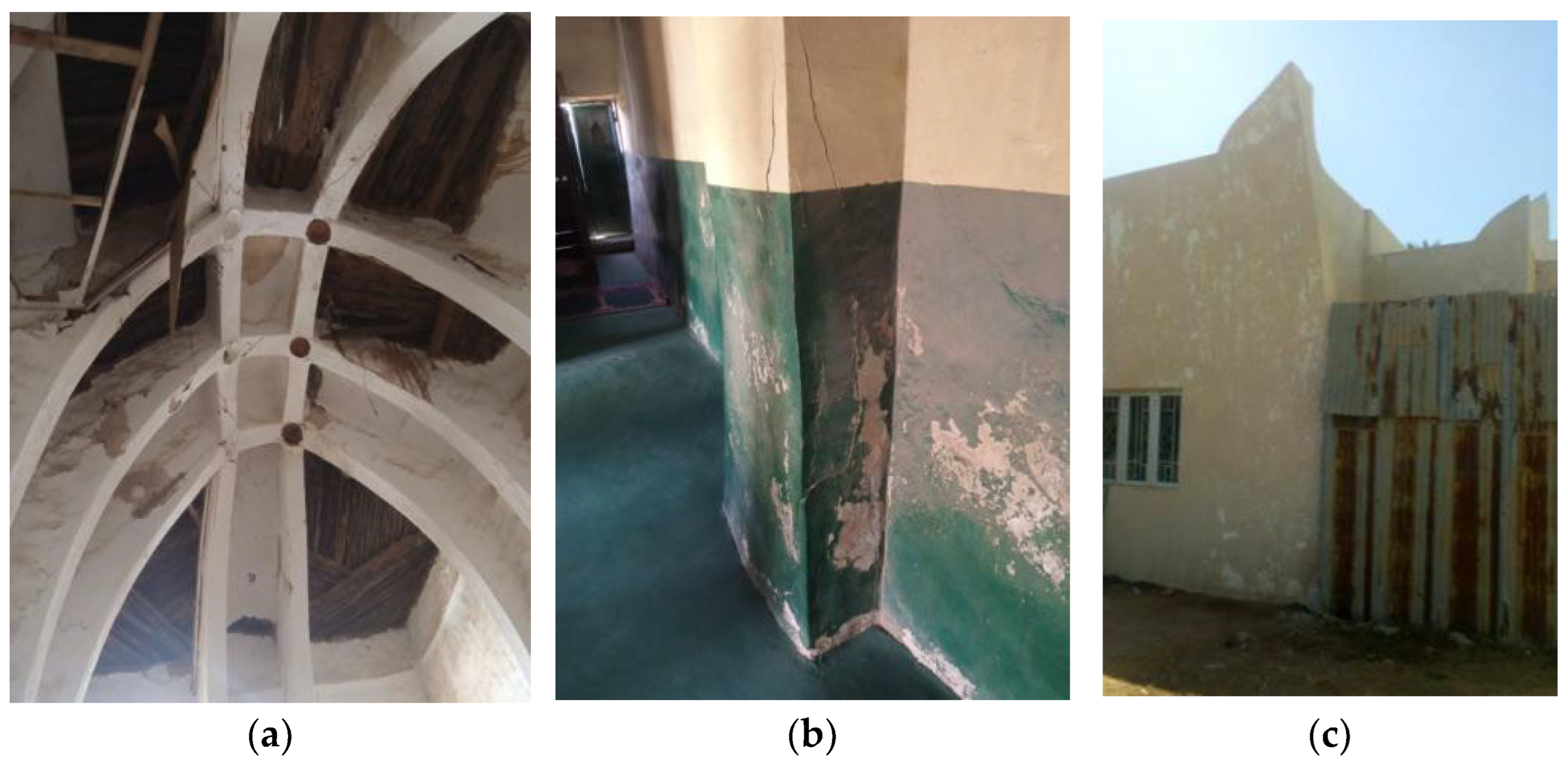


| S/No | Pre-Colonial Buildings | S/No | Colonial Buildings | S/No | Post-Colonial Buildings |
|---|---|---|---|---|---|
| 1 | Gidan Rumfa | 13 | Gidan Dan Hausa | 25 | Gidan Murtala |
| 2 | Gidan Makama | 14 | Resident quarters, Government House Kano | 26 | Gidan Ado Bayero |
| 3 | Kano Central Mosque | 15 | The British Council Building | 27 | Hasiya Bayero Pediatric Hospital |
| 4 | Dambazau Mosque | 16 | Rumfa College | 28 | Gidan Haruna Kasin |
| 5 | Wudilawa Mosque | 17 | Kano Railway Station | 29 | Mambayya House |
| 6 | Jalli Mosque | 18 | Masaka Textiles Factory | ||
| 7 | Galadanci Mosque | 19 | Gidan Goldie | ||
| 8 | Hausawa Mosque | 20 | Bello Dandago House | ||
| 9 | Dorayi Palace/Farm House | 21 | Eldorado Cinema | ||
| 10 | Gidan Nassarawa Mini Palace | 22 | Alhassan Dantata House | ||
| 11 | Masalacin Dandalin Turawa | 23 | Technical College K/Nassarawa | ||
| 12 | Gidan Shettima | 24 | Kofar Kudu Sharia Court |
| Variables | Sub-Variables | Description | |
|---|---|---|---|
| Location | District/Region | Outside the city wall by the western district of Kano city | |
| Coordinates | (11°57′53″ N, 8°28′26″ E) | ||
| Place, LGA | Dorayi, Kumbotso | ||
| Typology | Classification | Royal | |
| Function | Palace: territorial retreat | ||
| Transformation | Emir’s rural resort and farms (1800), mini palace | ||
| Spatial Information | Space Composition | The compound serves as a mini palace. It consists of a gate house leading to an open yard, the palace structure, a recently constructed council hall, garden, horses’ ranch, servants’ lodge, and stockpile.The palace building comprises zaure (pre-entrance), soro (ante-room), fada (palace chamber), harabar kuyangu (maids’/slave-girls’ spot), rumbu (hoard and stockpile), turakar sarki (Emir’s lodge), lambu (garden), and sashen kwara-kwarai (concubines’ quarter). | |
| Photographic Information | Figures |  Approach view of the palace | 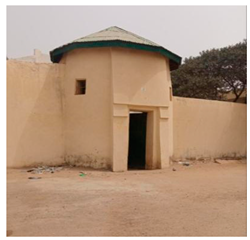 Palace entrance (Soron Sallama) |
| Remark | The main structure retains its appearance and form from ancient times also constructed with tubali (local mud bricks) and mortar, chafe/laso plaster, azara (coconut lumber), asabari (thatch/corn mat), and indararo (roof spout) made of local steel. | ||
| Variables | Sub-Variables | Description | |
|---|---|---|---|
| Location | District/Region | Within the city wall, north-west of the Kano Emir’s palace | |
| Coordinates | (12°00′18″ N, 8°30′26″ E) | ||
| Place, LGA | Shatsari/Dandali, Dala | ||
| Typology | Classification | Religous | |
| Function | Masjid (mosques), Madarasa (school of Islamic teachings); congregate daily and on Friday, Wazifa | ||
| Transformation | This began with the late Emir of Kano, Muhammadu Sunusi I, who re-established or changed the building materials from thatch, cornstalk mat walls, rope, reeds, and grasses to tubali (local mud bricks) and mortar, chafe/laso plaster, azara (coconut lumber), asabari (thatch/corn mat), and indararo (roof spout). It was subsequently renovated with cement mortar plaster by the late Emir of Kano, Sarki Abdullahi Bayero. | ||
| Spatial Information | Space Composition | The premises comprises an edifice entrance, ablution court, open courtyard, congregation hall, and classes. | |
| Photographic Information | Figures | 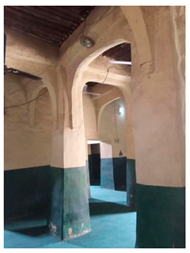 Congregation hall | 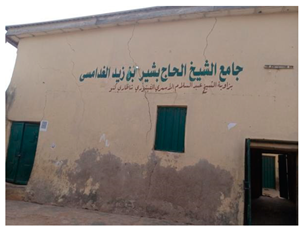 Approach view of Shatsari Mosque |
| Remark | The building retains its appearance and form but the mud roof deck was covered (against rain and wind storms) with a corrugated aluminum roofing sheet, two tubali (mud brick) columns, after Imam, were replaced with solid core sandcrete block columns, the original doors made of local steel were replaced by recent prefabricated steel doors. | ||
| Variables | Sub-Variables | Description | |
|---|---|---|---|
| Location | District/Region | Within the city wall, Murtala Muhammad Road, by the Emir’s Palace | |
| Coordinates | (11°59′42″ N, 8°30′57″ E) | ||
| Place, LGA | Close to Kano Central Mosque, Kano Municipal | ||
| Typology | Classification | Royal | |
| Function | Emirate council building | ||
| Transformation | It is said to have been transformed multiple times but the notable ones were overhauling the chafe/laso plaster (exterior finishing) to sandcrete plaster in the early 1970s, a rehabilitation in the mid-2010s where the terrace was converted to a colonnade and for the consideration of some security measures along the arcade. | ||
| Spatial Information | Space Composition | The pre-colonial (local mud bricks) structure is a storey lodge apartment comprising reception halls, rooms, balconies, open courtyards, and conveniences, while the colonial building entails a reception, chamber, rest-room, terrace, and offices as well as other auxiliary spaces. Nevertheless, the post-colonial structure has the same functional space with some modifications to the office spaces and extension of the colonnade. | |
| Photographic Information | Figures | 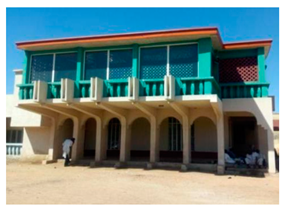 Approach view of colonial structure |  On-going rehabilitation work |
| Remark | It was awarded an upgrade on 24 June 2020 by the ministry of works and infrastructures for upgrade by the council of chiefs and office of the Emir of Kano state under the Kano state emirate council. | ||
| Variables | Sub-Variables | Description |
|---|---|---|
| Location | District/Region | Within the city wall, Gwammaja |
| Coordinates | (12°01′07″ N, 8°30′56″ E) | |
| Place, LGA | Gwammaja, Dala | |
| Typology | Classification | Industrial |
| Function | Multi-industry complex | |
| Transformation | According to [64], the eventual closure of industries by the 1970s, in Kano in particular, remains the essential crisis of Nigeria’s unfortunate industrial performance as compared to other developing nations. Consequently, Masaka textile shut down its operations by the end of the 1990s due to Nigeria’s macro-economic policy on industrial development in the Kano metropolis, best seen in the perspective of what ensued in the pre-Structural Adjustment Programme as well as the Structural Adjustment Programme (SAP) time. At the time of the survey, the mill was leased to about 22 small and medium-scale industries. | |
| Spatial Information | Space Composition | The factory premises constitute a clinic (with an upper floor), while the administrative building is attached to the production and storage section. |
| Photographic Information | Figures |  Approach view of administration area of Masaka textile mill |
| Remark | The structure retains its appearance and remains brawny, although it has undergone a series of patch, the most notable one being when the windows of the admin area were covered with 225 mm sandcrete blocks due to a change in use. |
| Variables | Sub-Variables | Description |
|---|---|---|
| Location | District/region | At the center of the Kano metropolis |
| coordinates | (11°59′17″ N, 8°31′07″ E) | |
| Place, LGA | Opposite the Emir of Kano’s Palace, Kano Municipal | |
| Typology | classification | Judiciary |
| Function | Sharia court complex | |
| Transformation | The notable transformation remain extended veranda converted to achieves and the abandoned western perimeter fence while courtrooms, some record rooms, judicial and administrators offices, and other auxiliary spaces remain in their original form.. | |
| Spatial Information | Space Composition | The complex constitutes three courtrooms, achieves/record rooms, judicial and administrators offices, gentlemens’ and ladies’ toilets, an open courtyard, vehicular parking, and other auxiliary spaces. However, the library, basic medical facility, video conferencing facility, and detention hall are missing. |
| Photographic Information | Figures | 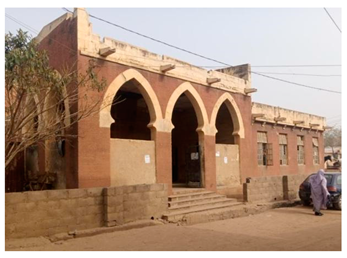 Approach view of Kofar Kudu sharia court |
| Remark | The structure remains strong, although it has undergone a series of maintenance works, the most notable ones were windows’ glass panels being replaced with plywood, ceiling boards, and a recently erected facility with 225 mm sandcrete blocks, which were necessitated due to an increase in population or demand. |
| Variables | Sub-Variables | Description |
|---|---|---|
| Location | District/Region | Sarari ward of Kano city |
| Coordinates | (11°59′17″ N, 8°31′07″ E) | |
| Place, LGA | Koki, Dala | |
| Typology | Classification | Mixed use: office and residential |
| Function | Residential | |
| Transformation | Parts of the brickworks were replaced with mud bricks (tubali) and 225 mm sandcrete blocks. Afterward, the burnt roof and collapsed slab were not restored, while the garden was converted into a graveyard where the late Alhaji Alhassan, his wives, and some of his children were buried. | |
| Spatial Information | Space Composition | The premises serves as the head office of Alhassan Dantata & Sons, a building contractor, groundnut buying agent, transporter, and retailer while comprising a reception hall, office allotment, hoard, stockpile, master segment, family wing, boys’ quarters, guest lodge, kitchen, and stores. Although a colonial building, it adopted Hausa traditional typology as it employs a zaure (reception hall) and soro (as office allotment) by the entrance, shago (boys’ quarters and guest lodge) adjacent to the entrance, turakar maigida (master wing), rumbu (hoard and stockpile) and lambu (garden) all link up via tsakar gida (courtyard) leading to a sashen mata (family wing) which is at the rear. |
| Photographic Information | Figures |  Approach view of Alhassan Dantata house |
| Remark | The building remains as it was in ancient times, although it has undergone a series of restorations, the most notable one being when the old master wing collapsed as a result of a fire outbreak and subsequent storms. |
| Variables | Sub-Variables | Description |
|---|---|---|
| Location | District/Region | Gwammaja by Kwanar Dala of Kano city |
| Coordinates | (12°00′53″ N, 8°30′21″ E) | |
| Place, LGA | Gwammaja, Dala | |
| Typology | Classification | Institutional |
| Function | Educational | |
| Transformation | The premises were vacated by the defunct CDS, which was scrapped in 1996, and later allotted in November 2000 as a unit for research and training under Bayero University, Kano (Aminu Kano Center For Democratic Studies). | |
| Spatial Information | Space Composition | The complex constitutes of Sa’adu Zungur Auditorium, Gambo Sawaba Suites, Magaji Danbatta Admin Block, Shatu Aminu Kano Restaurant, Mudi Sipikin Library, and Malam Aminu Kano Living History Museum, which is the only building preserved in its original state. The building, which was initially Malam Aminu Kano’s private residence, was later converted to a museum for the proper conservation of his chattels and political legacy as well. The compound consists of his wing (a terraced duplex comprising his couch, radio, caps, clothes, briefcases, library, credentials, photo album, tutorial class, and the bed where he died), an open courtyard, a women’s wing, classroom, kitchen, and store. |
| Photographic Information | Figures | 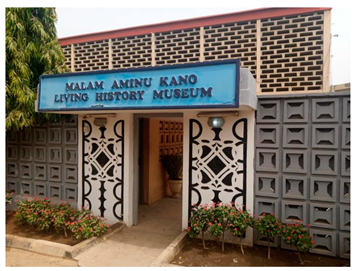 Entrance view of Malam Aminu Kano Living History Museum |
| Remark | The museum was built using prefabricated concrete and facing blocks, sandcrete plaster, wood, glass louvers, and asbestos roofing sheets, although, the glass louvers were replaced with aluminum sliding windows, and the asbestos roofing with corrugated aluminum roofing sheets. |
| Variables | Sub-Variables | Description |
|---|---|---|
| Location | District/Region | Outside the Kano city wall, north of the Kano Emir’s palace |
| Coordinates | (12°00′38″ N, 8°31′39″ E) | |
| Place, LGA | Bila Road off Abbale Street, Fagge C, Fagge | |
| Typology | Classification | Polygamy domicile |
| Function | Residence | |
| Transformation | The building was inherited by four of his children, consequently the house was subdivided where the rear part still serves as Fagge wafa commercial shops. | |
| Spatial Information | Space Composition | The compound comprises the master wing, family wing, and boys’ and guest quarters. As a colonial building it adopted the Hausa traditional concept; the plan typology employs dandali, soro, azure, shago, and tsakar gida while the concept of elevation embodies dandali, zanko, indararo, all in a contemporary approach. |
| Photographic Information | Figures | 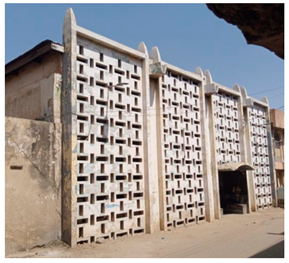 The approach view of Alhaji Haruna Kasim residence |
| Remark | The house was constructed with prefabricated facing blocks, sandcrete plaster, masonry walls, wood, steel casement window, glass louvers and galvanized zinc roofing sheets, although, some of the windows were replaced with aluminum sliding windows. |
| Variables | Sub-Variables | Description |
|---|---|---|
| Location | District/Region | A2, Kofar Nassarawa Kano |
| Coordinates | (11°59′29″ N, 8°31′53″ E) | |
| Place, LGA | Yakasai, Kano Municlpal | |
| Typology | Classification | Institutional |
| Function | Educational | |
| Transformation | Initially proposed as the corporate headquarters of KSIP and once known as Kano ICT tower, it was allotted to Yusuf Maitama Sule University Kano as the city campus. | |
| Spatial Information | Space Composition | The premises comprises the main tower, mosque, cafeteria, generator house, parking facilities, and other auxiliary structures. The main tower was initially designed as a mixed-use complex building with approximately eleven floors which comprises offices, collapsible spaces, suites, sky lobbies, a lift and stairways throughout its height, and surveillance decks. The tower heap is organized around a Y-shaped geometry (a central core with three wings) which allows passive cooling and the selection of structural systems varies from the third floor (reduction of the floor plan along the height) to proficiently narrow the building profile. |
| Photographic Information | Figures | 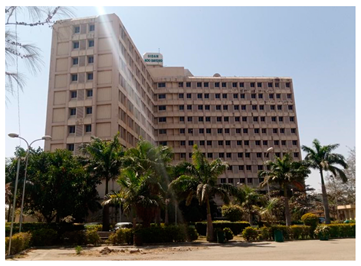 North view of Gidan Ado Bayero |
| Remark | The tower was constructed with glass/aluminum partitions, steel/wooden rails, porcelain tiles, gypsum ceiling, sandcrete walls, and plaster for the inner stance, while aluminum glass windows, louvers cladding, and prefabricated horizontal and vertical structural members envelop the outside. |
| S/No | Monumental Building | Observed Deteriorations | Documentation Methods | Diagnosis Methods | Treatment Interventions |
|---|---|---|---|---|---|
| 1 | Dorayi Mini Palace | Decay of chafe plaster on the internal walls at Soron Sallama | Digital Photography, Physical Assessment | Not into practice | -Patch-up of deteriorated areas with mixed makuba and laso |
| Deterioration of roof drains at Soron Sallama | -Mending of deteriorated roof components -Installation of zinc roofing sheet and ceiling board | ||||
| Termite attacks on the azara roof at Harabar Kuyangu and fada | -Fumigation of the affected spaces with pesticide -Installation of corrugated aluminum sheet and ceiling board | ||||
| Collapse of fence walls in parts of the palace | -Subtraction of the subsided local mud wall -Reconstruction of new walls using sandcrete blocks | ||||
| Slight and main cracks on the external walls | -Use of makuba (milled locust bean pod) bricks -Covering the tubali with laso mortar | ||||
| 2 | Shatsari Arab Mosque | Collapse of two load-bearing columns | Digital Photography, Physical Assessment | Not into practice | -Subtraction of the subsided local mud column -Reconstruction of new columns using solid core sandcrete blocks |
| Deteriorated portion of the roof at congregation hall | -Mending of deteriorated roof components -Installation of zinc roofing sheet and ceiling board | ||||
| Slight and main cracks on the walls as well as floors | -Repairing the cracks with sandcrete mortar | ||||
| Decay of chafe plaster on the internal and external walls of the entire building | -Replacement of the deterioration with sandcrete mortar | ||||
| 3 | Gidan Shattima | Deterioration of chafe plaster on the external walls of the pre-colonial building | Digital Photography, Physical Assessment | Not into practice | -Replacement of the deterioration with sandcrete mortar |
| Blockage of the indararo (roof drains) of the pre-colonial structure | -Removal of debris from the roof drains | ||||
| Deterioration of roofing sheet of the colonial structure | -Repair of roof leaching with bituminous felts -Substitution of dilapidated roofing sheet |
| S/No | Monumental Buildings | Observed Deteriorations | Documentation Methods | Diagnosis Methods | Treatment Interventions |
|---|---|---|---|---|---|
| 1 | Masaka Textile Mill | Destroyed and blown-off roofing sheets on the warehouses | Digital Photography, Physical Assessment | Not into practice | -Patch-up and substitution of the blown-off components with second-hand galvanized zinc sheets |
| Broken glass windows in admin block and clinic | -Restoration of broken glass along with the damaged louvers -Installation of plywood panels in place of some glass | ||||
| Slight cracks on the external walls | -Repairs of the deterioration with sandcrete mortar | ||||
| Blockage of the roof spout/drains of the structure | -Removal of debris from the roof drainages | ||||
| 2 | Kofar Kudu Sharia Court | Decay/microbial growth on the external walls of the building | Digital Photography, Physical Assessment | Not into practice | -Patch-up and repainting a few portions of the decay while the remainder is left due to poor funding |
| Growth of weeds on portion of the roof parapet and drainage | -Direct weeding of deteriorated roof components over time | ||||
| Damaged and blown-off roofing sheets by the overhang veranda converted to records | -Patch-up of the roof cover with other galvanized zinc sheets of lower quality | ||||
| Deteriorated portions in the roof ceiling | -Repairs of the leakages but deteriorated carcass remains untreated. | ||||
| Slight cracks on the external walls | -The cracks on the external walls remain untreated | ||||
| Broken doors and glass windows in the courtroom | -Repairs of the deteriorated glass components | ||||
| 3 | Gidan Alhassan Dantata | Slight and severe cracks on the walls and floors | Digital Photography, Physical Assessment | Not into practice | -Substitution of the deterioration with sandcrete mortar/screed |
| Damaged portion razed by fire outbreak | -Only patched-up with sandcrete mortar but portion razed by fire outbreak remains abandoned | ||||
| Deterioration of roofing carcass of the reception hall | -Repair of the leakages with bituminous felts - Substitution of dilapidated roof truss and sheets | ||||
| The collapse of fence walls in parts razed by fire outbreak | -Removal of the collapsed mud brick wall -Reconstruction of new walls using sandcrete blocks | ||||
| Blown-off roofing sheets by the overhang veranda of boys’ quarters | -Patch-up of the roof cover with other galvanized zinc sheets of lesser quality |
| S/No | Monumental Buildings | Observed Deteriorations | Documentation Methods | Diagnosis Methods | Treatment Interventions |
|---|---|---|---|---|---|
| 1 | Mambayya House | Broken louver glass in master wing | Digital Photography, Physical Assessment | Not into practice | -Substitution with aluminum sliding window |
| Broken glass of winging doors and windows all over the building | -Mending of deteriorated glass components with steel plate and glass of lower quality | ||||
| Moisture effects and minor cracks on the external walls | -Substitution of the deterioration with sandcrete mortar and painting -Repainting the screed and plastered surface | ||||
| Negligible cracks in the courtyard floor | -Substitution of the deterioration with interlocking tiles | ||||
| Poor outlook of the internal floor screed | -Replaced with acoustic/rubber floor tiles | ||||
| Poor outlook of asbestos roof covering | -Replaced with long-span aluminum roofing sheet | ||||
| 2 | Gidan Haruna Kasim | Minor cracks on the external walls | Digital Photography, Physical Assessment | Not into practice | -Minor cracks on the external walls remain untreated |
| Deteriorated portions in the roof ceiling | -Repairs of the roof leakages but deteriorated roof carcass remains neglected. | ||||
| Damaged roofing sheets by the courtyard | -Patch-up of deterioration with old galvanized zinc sheets | ||||
| Broken doors and windows in courtroom | -Repairs of the deteriorated glass components | ||||
| Decay/microbial growth on the external walls of the building | -Patch-up and repainting flaked portion while the remaining is left due to poor funding | ||||
| 3 | Gidan Ado Bayero | Stains of corroded metal on the encasement of the tower | Digital Photography, Physical Assessment | Not into practice | -Stains remain untreated |
| Decay/microbial growth on the external walls of the building | -Patch-up and repainting of the deterioration | ||||
| Damaged porcelain floor tiles along stair lobby, classrooms, offices, and corridor | -Substitution of deterioration with same materials but different color and surface patterns | ||||
| Collapsed gypsum ceiling along hallways, classrooms and offices | -Restoration of the deterioration -Replacement of decay with same materials with different surface patterns | ||||
| Broken terrazzo steps in the auditorium | -Patch-up of deterioration with sandcrete mortar |
| S/No | Selected Buildings | Intervention Progression | ||
|---|---|---|---|---|
| Renovation (Mend) | Restoration (Reconstruction) | Retrofit (Upgrade) | ||
| 1 | Dorayi Mini Palace | |||
| 2 | Shatsari Arab Mosque | |||
| 3 | Gidan Shattima | |||
| 4 | Masaka Textile Mill | |||
| 5 | Kofar Kudu Sharia Court | |||
| 6 | Gidan Alhassan Dantata | |||
| 7 | Mambayya House | |||
| 8 | Gidan Haruna Kasim | |||
| 9 | Gidan Ado Bayero | |||
Disclaimer/Publisher’s Note: The statements, opinions and data contained in all publications are solely those of the individual author(s) and contributor(s) and not of MDPI and/or the editor(s). MDPI and/or the editor(s) disclaim responsibility for any injury to people or property resulting from any ideas, methods, instructions or products referred to in the content. |
© 2023 by the authors. Licensee MDPI, Basel, Switzerland. This article is an open access article distributed under the terms and conditions of the Creative Commons Attribution (CC BY) license (https://creativecommons.org/licenses/by/4.0/).
Share and Cite
Yusuf, D.A.; Ahmed, A.; Zhu, J.; Usman, A.M.; Gajale, M.S.; Zhang, S.; Jialong, J.; Hussain, J.U.; Zakari, A.T.; Yusuf, A.A. Quest for an Innovative Methodology for Retrofitting Urban Built Heritage: An Assessment of Some Historic Buildings in Kano Metropolis, Nigeria. Buildings 2023, 13, 1899. https://doi.org/10.3390/buildings13081899
Yusuf DA, Ahmed A, Zhu J, Usman AM, Gajale MS, Zhang S, Jialong J, Hussain JU, Zakari AT, Yusuf AA. Quest for an Innovative Methodology for Retrofitting Urban Built Heritage: An Assessment of Some Historic Buildings in Kano Metropolis, Nigeria. Buildings. 2023; 13(8):1899. https://doi.org/10.3390/buildings13081899
Chicago/Turabian StyleYusuf, Danjuma Abdu, Abubakar Ahmed, Jie Zhu, Abdullahi M. Usman, Musa S. Gajale, Shihao Zhang, Jiang Jialong, Jamila U. Hussain, Abdullahi T. Zakari, and Abdulfatah Abdu Yusuf. 2023. "Quest for an Innovative Methodology for Retrofitting Urban Built Heritage: An Assessment of Some Historic Buildings in Kano Metropolis, Nigeria" Buildings 13, no. 8: 1899. https://doi.org/10.3390/buildings13081899
APA StyleYusuf, D. A., Ahmed, A., Zhu, J., Usman, A. M., Gajale, M. S., Zhang, S., Jialong, J., Hussain, J. U., Zakari, A. T., & Yusuf, A. A. (2023). Quest for an Innovative Methodology for Retrofitting Urban Built Heritage: An Assessment of Some Historic Buildings in Kano Metropolis, Nigeria. Buildings, 13(8), 1899. https://doi.org/10.3390/buildings13081899











